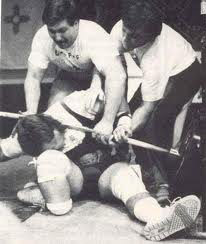- Like
- SHARE
- Digg
- Del
- Tumblr
- VKontakte
- Flattr
- Buffer
- Love This
- Save
- Odnoklassniki
- Meneame
- Blogger
- Amazon
- Yahoo Mail
- Gmail
- AOL
- Newsvine
- HackerNews
- Evernote
- MySpace
- Mail.ru
- Viadeo
- Line
- Comments
- Yummly
- SMS
- Viber
- Telegram
- JOIN
- Skype
- Facebook Messenger
- Kakao
- LiveJournal
- Yammer
- Edgar
- Fintel
- Mix
- Instapaper
- Copy Link
Injury Prevention Tips for Bodybuilders
 As a bodybuilder and avid exerciser, I know first-hand how injuries can affect your workout performance in the gym.
As a bodybuilder and avid exerciser, I know first-hand how injuries can affect your workout performance in the gym.
Injuries slow down your progress by forcing you to work around movements, lightening the load, and taking time off.
Successfully preventing injury from occurring in the first place is the best case scenario, but there are no guarantees when it comes to preventing injury. However, by following these tactics you can greatly reduce the risk of incurring a weight training related injury.
Adequate Warm-up
Too often bodybuilders jump from zero to their peak weight without adequately warming up their muscles and connective tissues. This type of training philosophy can leave bodybuilders prone to muscular or joint injuries.
Therefore, a proper warm-up should be a staple in your exercise routine. According to International Sports Sciences Association, warming up increases muscular strength, contractibility, extensibility, reduces the risk of injury, and prepares the connective tissue for work1.
To avoid wear and tear on your cold muscles, joints, and tendons try performing at least 2-3 lighter sets gradually progressing up to your max workload.
Proper Form
Using faculty biomechanics or bad form such as bouncing, jerking, or heaving while exercising with heavy resistance can potentially cause a damaging amount of stress to your connective tissues. However, using proper form can prevent you from causing any unnecessary stress or tension to your joints or tendons.
In weight training, proper form should ensure two things. First, the muscles you’re working receive full stress from the exercise performed, and second, your body is positioned in such a way that your muscles and joints are in the strongest position possible, thereby reducing the risk of training injuries.
To help maintain proper form during your workout, try exercising in front of the mirror for self correction, training with an experienced workout partner, or hiring a certified personal trainer.
Recovery
Recovery is generally one of the most over-looked parts to a strength training program. During the recovery stage, the body repairs, rebuilds, and strengthens itself. However, without sufficient time to repair and replenish, the body will continue to breakdown from intensive exercise increasing your risk for overuse injuries.
In addition to, excessive training has been shown to significantly decrease strength1. How much rest between weight training sessions do you need? Depending on several variables like volume and intensity, your muscles could take anywhere between 24 – 72 hours to recover.
Bodybuilders who train on consecutive days should do so performing a weight training split. A weight training split allows for recovery and aides in preventing overuse injuries by alternating the muscles exercised during a workout (Learn more about weight training splits here).
Consistently training hard enough to make progress from your workouts is hard enough already without injury. Warming up, using good form, and allowing yourself adequate recovery time can help you stay injury free while still pushing yourself to the max.
Bodybuilding Injury Prevention 101: References
1^ “ Fitness: The Complete Guide;” International Sports Sciences Association; 2007
About Julian Brown
JulianBrownTraining.com Julian is the co-owner of The Yard Fitness, an established fitness writer, a professional natural bodybuilder, a fitness & sport nutrition specialist, and a certified personal trainer. He began strength training at the young age of fourteen to improve his sports performance and hasn’t looked back since. Julian is a graduate of Grambling State University, ACE & NASM certified, and he has over a decade of personal experience in strength training.

Hi, I am 20 years old and do weight training with the aim of gaining muscle mass, I have been doing this for a couple of years but have recently encountered problems with a bulging disc in my lower back which presses on my sciatic nerve, now I am unsure which exercises to do to continue doing weights with the restrictions of not being able to squat or deadlift or any thing bending over, any suggestions?
You’ll probably want to avoid any exercise that causes spinal compression. With that being said, you can still build up your legs using Bulgarian Split Squats with dumbbells, Leg Presses, Single Leg Presses, Lunges with dumbbells, Step Ups, and Pistol Squats. I hope your back feels better soon and best of luck with your training.